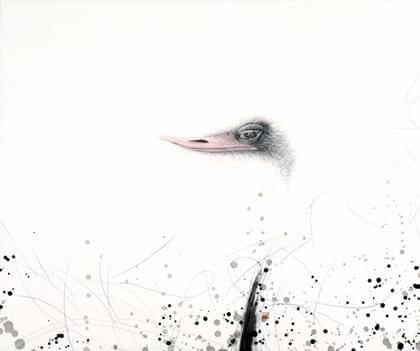With a pair of unlikely subjects — ostriches and irises — Japanese painter Kotaro Fukui probes the mystical relationships between light and dark in “Ostriches and Silent Flowers,” currently on view at the Crossing Art Gallery at Queens Crossing in downtown Flushing.
The exhibit is anchored by “Flightless,” which uses a series of images of ostriches to investigate movement through line, and the “Silent Flowers” series, which parades a luscious blue iris motif across brilliant, majestic gold backgrounds. These two bodies of work are accentuated by Fukui's Kimono paintings, fashion masquerade body painting photographs and “Ostrich Eggs” and “Abstract Ostrich” series.
In his work Fukui investigates the spaces that divide light and dark. For example, the rotund shape and rich black coloring of the ostrich's body in juxtaposition to the linear shape of the bird's extended neck set the stage for the magnetism of opposites.
The use and specific intention of negative space is critical in distinguishing Oriental artistic traditions from Western ones. In East Asia, negative space is not simply decorative but has meaning, as many Asian artists portraying nature have attempted to express a world in the depth of space.
“In the same way a man breathes, a Japanese painting breathes and has life,” Fukui says.
Fukui's work is notably steeped in both tradition and the avant-garde. As a fourth-generation artist, he grew up bounded within the traditions of Nihonga, or conventional Japanese painting style, and the Japanese modern art world. His father was active in the passionate Japanese modern art movement of the 1960s and '70s, while his great-grandfather, Koutei Fukui, was a master of Nihonga and an important figure in the Japanese art world who worked to prevent the traditional from being subsumed by the rising popularity of Western-style art in the early 1900s.
Though deeply influenced by noted Japanese artist Matazou Kayama, Fukui has found a subject and theme uniquely his own in the ostrich. Fascinated by the beautiful eyes and the shape of the ostrich, he uses the large, flightless bird as a body in which to convey the existence of opposites and as a means for the exploration of those opposites.
Similarly, the “Silent Flowers” series, which traces the blooming of irises throughout the daily rising and setting of the sun, concerns itself with the comparison of light and dark. When overwhelmed by sunlight the flower opens, and lacking light the flower closes. Since ancient times, Far Eastern philosophies have held a blooming iris as a talisman against evil.
“In our heart and in the society, there exists the light and the darkness. They never leave our hearts,” Fukui says in a statement on the series. “I want to give off the light in the darkness, existing in the same place without change, linking the past, present, and future. At the same time, I want to paint something that questions our existence, which investigates the truth in the light and darkness.
“I paint, with these thoughts in my mind. Working through the early morning light, the noon light, the light that is from the afternoon to the evening, the light of the candle and the lamp at night has changed. Now there lies only my work, the light that surrounds us, changing every moment just like our daily lives.”
“Ostriches and Silent Flowers” is on view through July 26.

































